- About
- Programs
- Issues
- Academic Freedom
- Political Attacks on Higher Education
- Resources on Collective Bargaining
- Shared Governance
- Campus Protests
- Faculty Compensation
- Racial Justice
- Diversity in Higher Ed
- Financial Crisis
- Privatization and OPMs
- Contingent Faculty Positions
- Tenure
- Workplace Issues
- Gender and Sexuality in Higher Ed
- Targeted Harassment
- Intellectual Property & Copyright
- Civility
- The Family and Medical Leave Act
- Pregnancy in the Academy
- Publications
- Data
- News
- Membership
- Chapters
The 2021 AAUP Shared Governance Survey: Findings on Faculty Roles by Decision-Making Areas
Published July 2021.
I. Introduction
For more than a century, the AAUP has conducted or sponsored national shared governance surveys. Each of these surveys has provided a snapshot of the state of shared governance at the time it was conducted, and together they provide vital information about the historical development of academic governance in the United States over the past one hundred years. The two most recent surveys—one conducted by the AAUP in 1971 and the other conducted by a doctoral student with AAUP sponsorship in 2001—featured assessments of areas of decision-making using a scale of levels of faculty authority (the 1971 survey looked at thirty-one areas, and the 2001 survey considered fifteen).[1] In the 2021 AAUP Shared Governance Survey, the first such survey in two decades and the subject of this report, I included questions about the level of faculty authority in twenty-nine areas. The survey provides a new snapshot comparing findings from previous years and gauging the impact of developments that have occurred in the intervening years. To achieve the latter objective, this year’s survey includes such topics as policies on intellectual property rights and modes of course delivery.
Unlike AAUP-supported standards relating to academic freedom, tenure, and due process, which can be highly specific, AAUP-recommended governance standards tend to be general, reflecting the understanding that governance practices vary among institutions according to size, mission, history, presence or absence of collective bargaining, and other factors. The Statement on Government of Colleges and Universities, the AAUP’s foundational document on academic governance, identifies decision-making areas in which the faculty should exercise “primary responsibility” (corresponding approximately to “faculty primacy” in the survey), but it also identifies decision-making areas in which the faculty should participate meaningfully without exercising primary responsibility. Since the conception of shared governance incorporates the notion that the level of faculty authority in decision-making differs between decision-making areas, the AAUP’s recommended governance standards specify expectations for minimum levels of faculty participation in many such areas. A national survey can provide information about what practices prevail nationally, how they differ among different types of institutions, and how they compare with normative standards of academic governance. Given the availability of historical data, the AAUP’s survey can also be used to track the development of shared governance.
In addition, the results of this survey can provide users with benchmarks to compare their governance practices with national trends. To that end, the AAUP’s research department will provide a version of the questionnaire for local use following the publication of this report.
II. The Composition of the Population
The 2021 AAUP Shared Governance Survey considered a representative sample drawn from a population of 1,400 four-year institutions of higher education that the Carnegie classification system classifies as bachelor’s, master’s, or doctoral institutions. Excluded from this population are two-year colleges, for-profit institutions, and specialized institutions, such as seminaries or free-standing law schools, as well as all-online universities. The findings in this report are intended to be generalized to this larger population.
According to the Integrated Postsecondary Education Data System (IPEDS), private nonprofit institutions make up 62 percent and public institutions compose 38 percent of the population studied here. The distribution of institutions by Carnegie classification is as follows: 27.5 percent are doctoral institutions, 42.0 percent are master’s institutions, and 30.5 percent are bachelor’s institutions. Eighty-seven percent of institutions in the population have a tenure system. I included responses about full-time faculty members at institutions without a tenure system in the full-time non-tenure-track category throughout this report. For additional information about how I drew the sample for this survey, as well as other information about methodology, please see the appendix.
IPEDS does not collect information on faculty collective bargaining, so the AAUP’s questionnaire asked whether different groups of faculty members were unionized in order to analyze possible differences in governance practices by collective bargaining status. Table 1 provides estimates of the prevalence of faculty unions based on responses to the survey questions for each of three groups: tenured and tenure-track, full-time non-tenure-track, and part-time non-tenure-track faculty members.

III. Areas of Decision-Making
Table 2 lists the twenty-nine areas of institutional decision-making with the wording used in the questionnaire. I organized the areas into three groupings—academic, personnel, and administrative—based on Joseph W. Garbarino and Bill Aussieker’s analysis of the 1971 AAUP governance survey.[2] My intention was to group related areas together, although obviously I could have placed some areas in more than one grouping. Since other studies have used Garbarino and Aussieker’s groupings, I tried to follow their division as closely as possible.
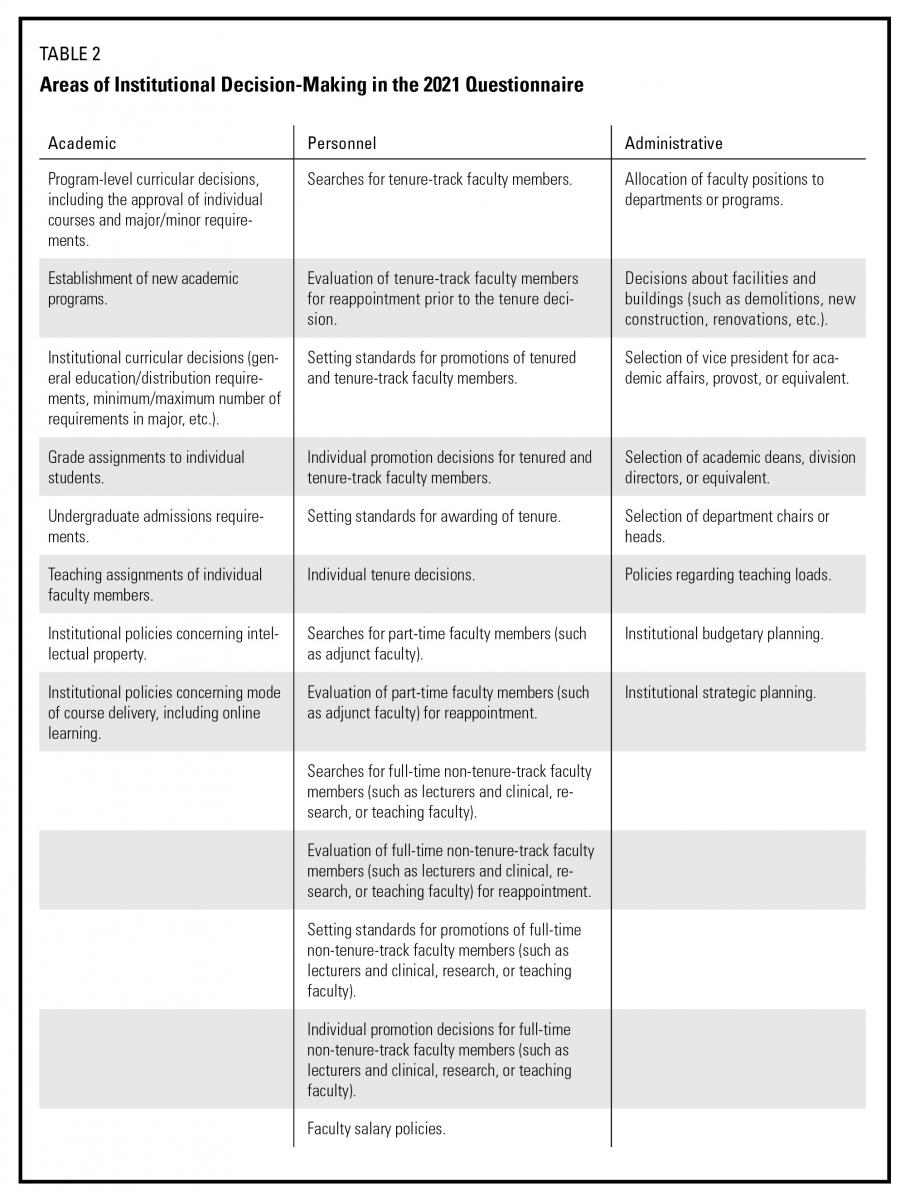
I added areas new to this year’s survey to the three groupings where they seemed to fit best. The new areas include “institutional policies concerning intellectual property” and “institutional policies concerning mode of course delivery, including online learning.” Additionally, I divided areas in the personnel grouping into three types of faculty appointments (tenured and tenure-track, full-time non-tenure-track, part-time non‒tenure-track), and I separated faculty authority in setting standards for promotion and tenure from faculty authority in decision-making in the various areas. Finally, I added “selection of vice president for academic affairs, provost, or equivalent” as well as questions about dean and chair selection. I discuss below areas included in the 1971 survey that the 2021 survey omitted.
IV. The Survey Scale
The scale on which respondents assessed the faculty role in decision-making for each area consisted of the following five categories: administrative dominance, administrative primacy, shared authority, faculty primacy, and faculty dominance. I adapted the names and definitions of the scale points from a 1967 study.[3] The questionnaire contained the following definitions:
Dominance: A group is making decisions in an area essentially unilaterally. The other group is informed of the decision or consulted in a pro forma fashion but generally has no influence on the outcome.
Primacy: A group has primary authority for an area but the other group has an opportunity to participate meaningfully in the final decision. If there is disagreement between the two groups, the group that has primacy normally prevails.
Joint Authority: This level of participation means that both groups exercise equal influence in making decisions in an area. If an area is subject to collective bargaining between a union and the administration or board, the level of faculty participation should presumably be “joint authority.”
Faculty: If decisions in a particular area are made by the department chair or head, they should be considered as being made by the faculty if heads or chairs are chosen by departmental election on a regular schedule. Otherwise, faculty participation needs to occur through an elected senate or council or through the general faculty.
Administration: Deans, associate deans, provosts, associate provosts, etc. should be regarded as administration, regardless of whether they may hold faculty rank. Department chairs or heads who are not chosen by departmental election on a regular schedule should be regarded as administration.[4]
The questionnaire provided the following instructions in the section on assessing faculty authority by area:
For each of the following areas of decision-making, please provide your assessment of the level of faculty participation before the COVID-19 pandemic. In judging the level of faculty participation, please assess the actual practice as employed on campus rather than how the level of faculty participation is specified in institutional regulations or bylaws.
To capture the overall development of governance since 2001 and to avoid findings about governance practices that might have been skewed by the impact of the COVID-19 pandemic, the questionnaire emphasized the importance of assessing governance for the areas under discussion prior to the pandemic. It contained additional questions about governance practices since the beginning of the pandemic, which were the subject of a separate AAUP report.[5] Furthermore, the focus on governance practices rather than on governance policies is essential because, first, institutional regulations frequently stress the final authority of the governing board even though in practice the board regularly delegates that authority in certain areas to the faculty or to the administration and, second, some institutional regulations contain lofty pronouncements about the administration’s and board’s commitment to shared governance that actual practice may not reflect. Because of the focus on governance practices, the questionnaire did not ask about rare occurrences, such as dismissals for cause or program eliminations, because the respondent most likely could not have adequately assessed the level of faculty participation in those areas as a matter of general practice.[6] Since governance practices in the areas under consideration can differ among departments, colleges, or schools, the questionnaire asked respondents to report their estimation of the most common form of faculty authority across units.
V. Findings
This report presents the findings of the survey as diverging stacked bar charts, a common format for the presentation of data collected on so-called Likert scales, which are ordered to measure attitudes, such as agreement, with scale points that express the intensity of the attitude. Such bar charts depict the percentage of responses for each category in order on the scale, with the bars centered on the midpoint of the scale at a point that represents the middle or neutral category (for example, “neither agree nor disagree” in a Likert scale of agreement). In this case, the categories are ordered from least to most faculty authority, and the middle category is “joint authority”—equal faculty and administrative authority.
As noted above, AAUP-supported standards of academic governance reflect an expectation that the level of faculty authority will differ between areas of decision-making. The questionnaire accordingly stated, “Although the order of the forms of participation listed here are in descending degree of faculty participation, it is not meant to imply that ‘faculty dominance’ is considered more desirable than the other categories for all of the questions listed.” Thus, when assessing many of the above-listed areas that are identified as academic, “administrative primacy” would probably fall below the level established under AAUP-supported standards, but in the case of some of the areas identified as administrative, in particular budgets, “administrative primacy” in general would still signify that faculty members had the opportunity to participate meaningfully in decision-making—in other words, in some of these areas, administrative dominance, but perhaps not administrative primacy, would be at odds with AAUP-supported governance standards. However, the AAUP did not formulate governance standards with the categories of faculty authority used in this survey in mind, so in some cases I have based the comparison of findings to governance standards on an interpretation of those standards rather than on an explicit statement of policy with respect to minimum levels of faculty participation.
A. The Academic Grouping
The areas in the academic grouping show a wide range of response patterns (figure 1). Faculty authority for individual grade assignments, a core area of academic freedom, is a faculty prerogative at a large majority of institutions, with 99.1 percent reporting the level as faculty primacy or faculty dominance. At the other end of the spectrum are undergraduate admissions standards and policies related to intellectual property, both of which are areas of faculty primacy or dominance at only 11 percent of institutions. Teaching assignments and mode of course delivery are related areas yet show a fairly wide disparity in faculty authority, with faculty primacy or dominance at 64 percent and 36 percent, respectively.
The share of faculty control in curricular decisions declines from the programmatic or departmental level to the institutional level and is sharply lower with respect to decision-making about creating new programs, with the combined share of faculty primacy and faculty dominance going from 76 percent to 60 percent to 31 percent, respectively. To the extent that the level of faculty authority in these three areas falls below faculty primacy, institutional responses would seem to represent a departure from normative standards of academic governance as set forth in the Statement on Government.
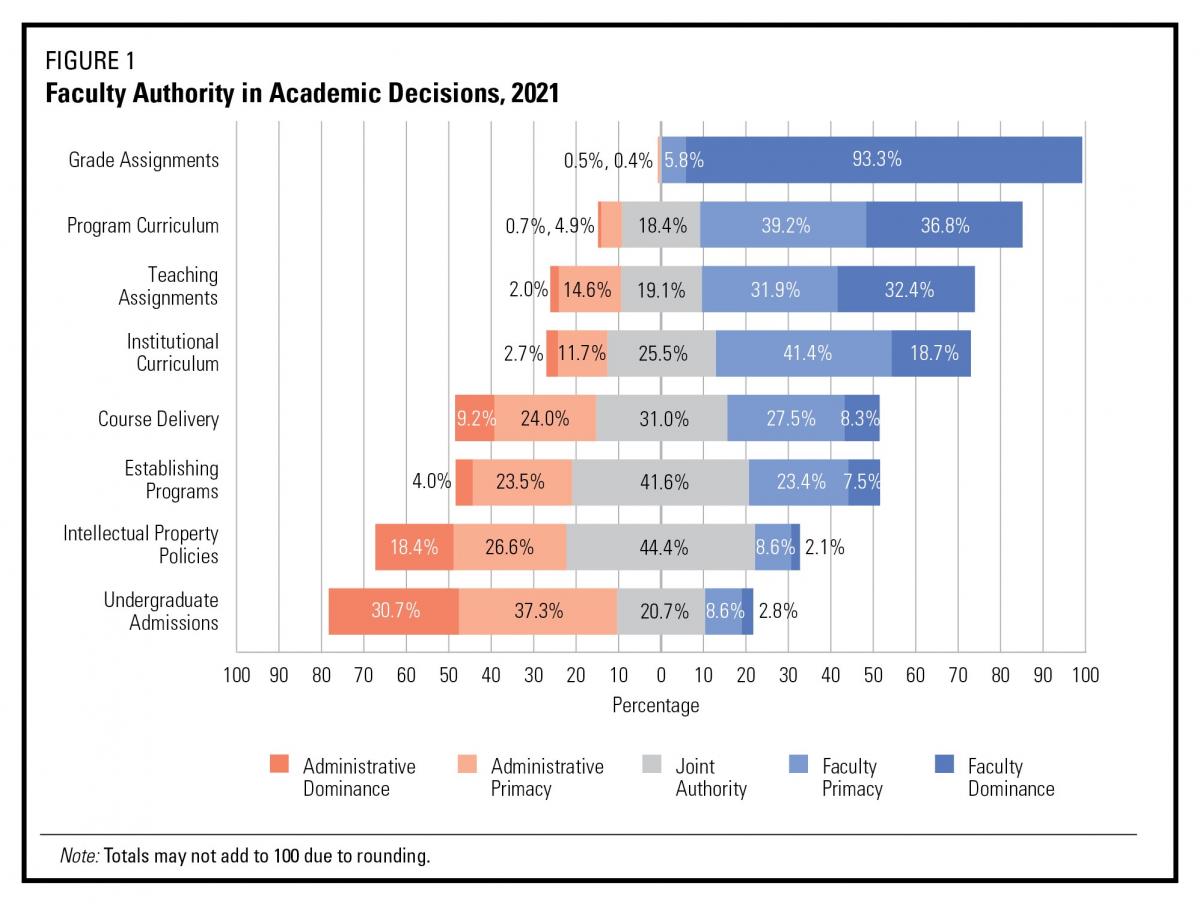
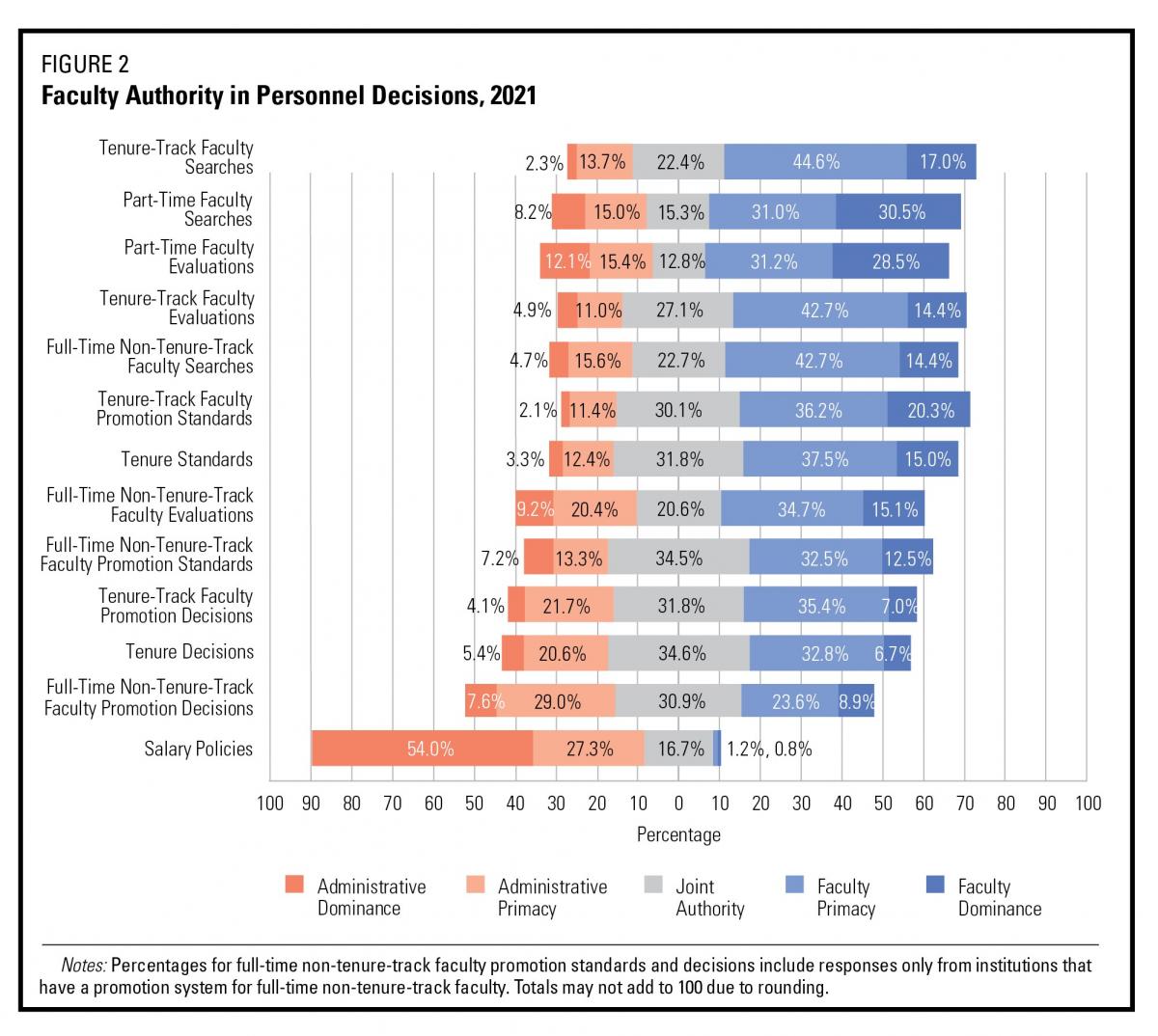
B. The Personnel Grouping
Several patterns emerge from the findings summarized in figure 2. First, the level of faculty authority for various types of personnel decisions by faculty group (tenured and tenure-track, full-time non‒tenure-track, part-time non‒tenure-track) ranks as follows, from greatest to least: (1) searches, (2) evaluations, (3) standards, and (4) decisions. (The latter two apply only to full-time faculty members, as systems of promotion and tenure for part-time non-tenure-track faculty members are rare.)
Second, the relative positions of the various faculty groups in figure 2 are notable: the percentage of respondents reporting faculty primacy or dominance is lower for personnel decisions concerning full-time non-tenure-track faculty members than for those concerning tenured and tenure-track faculty members. This pattern appears to be attributable primarily to the fact that full-time faculty members at institutions without a tenure system are included in the full-time non-tenure-track category. Because the faculty role at institutions without a tenure system is weaker overall than it is at institutions with a tenure system (an issue that will be taken up in more detail in a subsequent report), that group of institutions contributes to a lowering of the level of faculty authority for personnel decisions concerning full-time non-tenure-track faculty members.
The relatively high level of faculty authority for decisions concerning part-time non-tenure-track faculty members likely reflects the fact that hiring decisions for part-time faculty members are usually made at the departmental level with little administrative oversight. The reported prevalence of administrative primacy and administrative dominance may result from the fact that department chairs are typically making those decisions at institutions where they are not selected by the faculty, in which case the questionnaire instructed respondents to treat the chair as an administrator.
While the levels of faculty authority among the twelve areas related to faculty status vary somewhat, the most notable difference is between faculty status and salary policies. At 54.0 percent of institutions, administrations set salary policies essentially unilaterally (administrative dominance), while at 27.3 percent of institutions, the faculty has some opportunity to participate (administrative primacy). The faculty and the administration have an equal say in setting salary policies (joint authority) at only 16.7 percent of institutions.
C. The Administrative Grouping
In areas categorized as administrative, responses of administrative dominance, because they indicate that faculty members have no meaningful involvement of any kind, would fall short of Association-supported governance standards (figure 3). Nonetheless, administrative dominance is the most common response across all institutions in decisions about campus buildings (71.8 percent), budgets (63.3 percent), and allocations of faculty positions (45.2 percent).
Association-supported governance standards concerning the selection of administrators such as academic deans or vice presidents arguably call for at least joint authority in decision-making, which only about one-fifth of institutions report for the selection of deans (19 percent) and provosts (18 percent). However, three-fifths report at least that level of faculty authority for the selection of department chairs (60 percent).
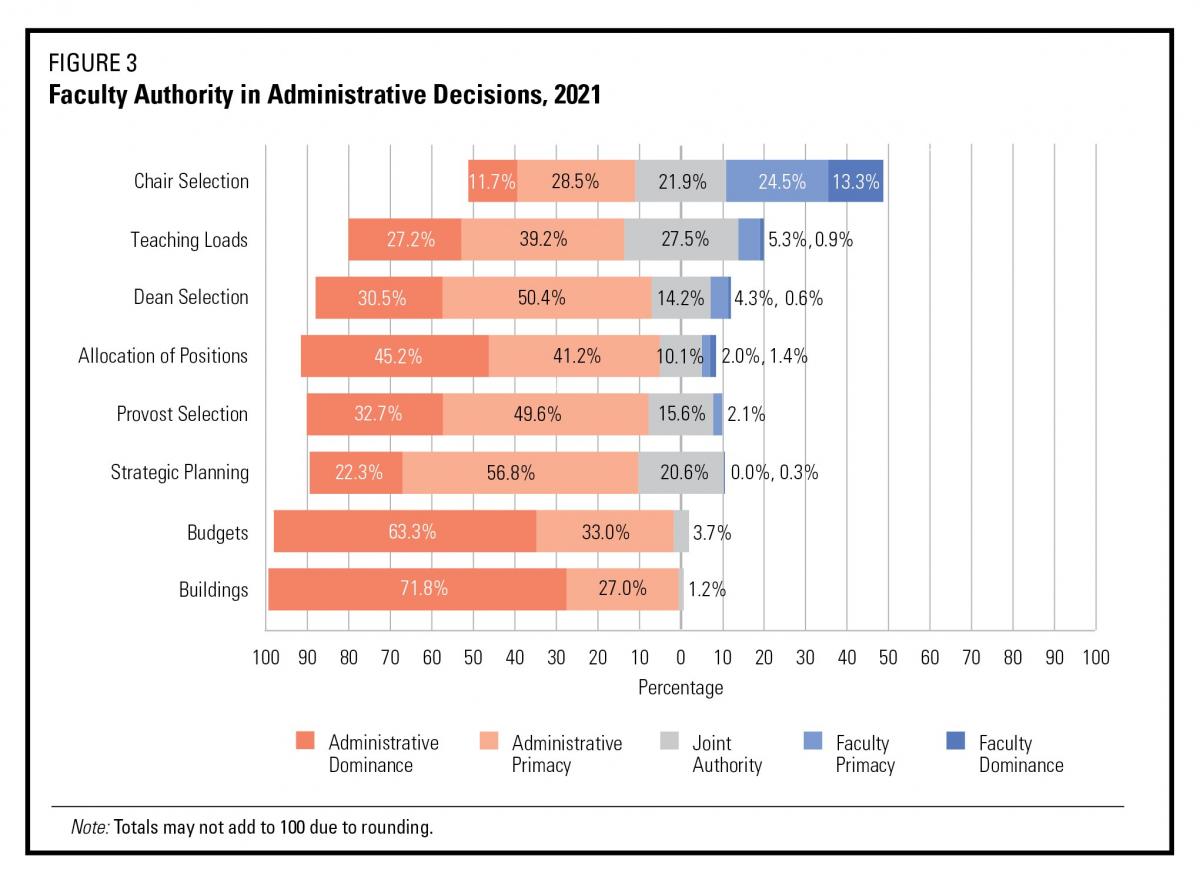
D. Carnegie Classification
Comparisons of institutional reports by Carnegie classification provided here distinguish among only three broad classifications: doctoral, master’s, and bachelor’s institutions. Nine of the twenty-nine decision-making areas displayed statistically significant differences between the institutional types. The findings are summarized in figure 4.
Higher levels of faculty authority exist at bachelor’s institutions relative to other institutional types in the allocation of faculty positions, institutional curricular decisions, teaching assignments, and chair selection. Doctoral institutions show higher levels of faculty authority in dean selection and undergraduate admissions. Master’s institutions fall below both doctoral and bachelor’s institutions in tenure and promotion decisions, while they are above both types of institutions in decisions about salary policies. The latter finding may be attributable to the higher prevalence of collective bargaining among master’s institutions.

E. Collective Bargaining
When comparing faculty authority in decision-making at institutions where the faculty bargain collectively with those where they do not, the most important caveat is that, for areas that are subject to bargaining, joint authority is the normative level of faculty authority, since, by definition, decisions in those areas require the agreement of both parties. Thus, a comparison that does not take the special status of joint authority into account misses an essential difference between unionized and nonunionized settings.
Perhaps the most important overall conclusion to be drawn from the comparison of unionized and nonunionized institutions is that statistically significant differences in the level of faculty authority appear in only seven of the twenty-nine areas. That finding is important because of long-standing debates about whether significant differences in governance practices exist between unionized and nonunionized institutions.
Consistent with findings dating back to 1977, this year’s survey found that institutions where the faculty engage in collective bargaining have higher levels of faculty authority in areas related to salary policies, teaching load, and chair selection (see figure 5).[7] The survey also found that faculty at unionized campuses have greater authority in dean selection and higher levels of authority in two areas that directly relate to terms and conditions of employment: policies related to intellectual property and policies related to modes of instruction, including online teaching.
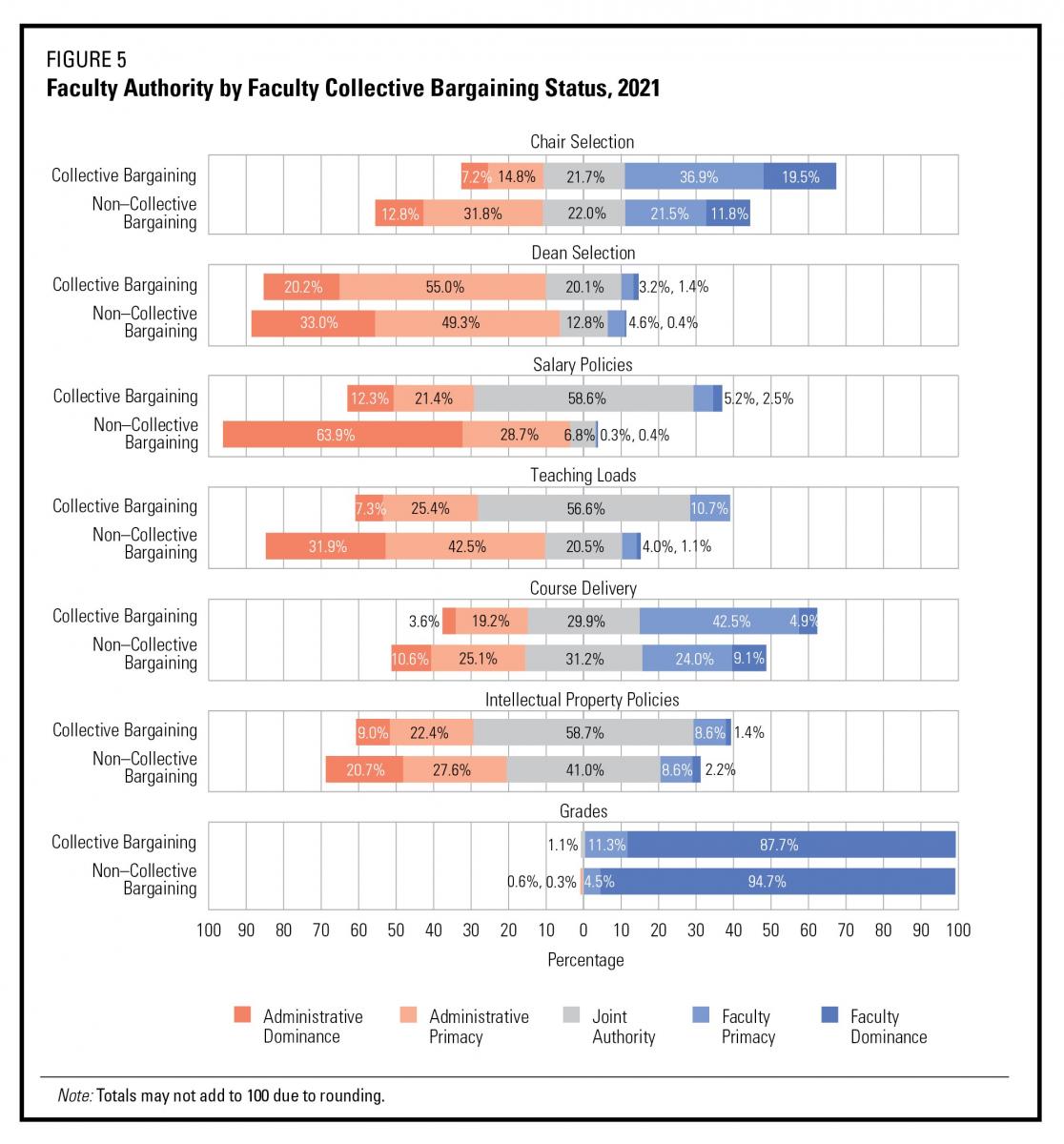
Some may find it surprising that a higher percentage of respondents at collective bargaining institutions identified faculty primacy rather than faculty dominance as the level of faculty authority in grade assignments (4.5 percent compared with 11.3 percent), the reason for which is not clear but which could reflect differences between unionized and nonunionized institutions in the handling of grade appeals.
VI. Comparison: 1971‒2021
A major innovation of the 1971 AAUP governance survey was the introduction of a five-point scale to assess faculty participation in decision-making, which is described in table 3. The 2001 Kaplan survey followed the 1971 survey in using the same scale. Although it would have been desirable to use the same scale for the current survey to facilitate direct comparisons, that scale had several disadvantages that ultimately outweighed that advantage. Perhaps most notably, even though the 1971 survey explicitly set out to compare governance practices to the standards set by the then recently formulated Statement on Government, it did not include faculty primacy, arguably the most central concept advanced by the Statement, as a scale point. Instead, the scale provided only “joint action,” corresponding to joint authority on the present scale, followed by “determination” as the next highest scale point, which corresponds to faculty dominance in the present scale. A second disadvantage is that the 1971 scale combined measures of the extent of faculty participation (none, joint action, determination) with the mode of faculty participation (discussion, consultation), and thus the scale was not in a technical sense “unidimensional.” Table 3 identifies scale points from the 2021 scale that are defined analogously on the 1971/2001 scale and approximate locations of scale points that have no analogue on the other scale.
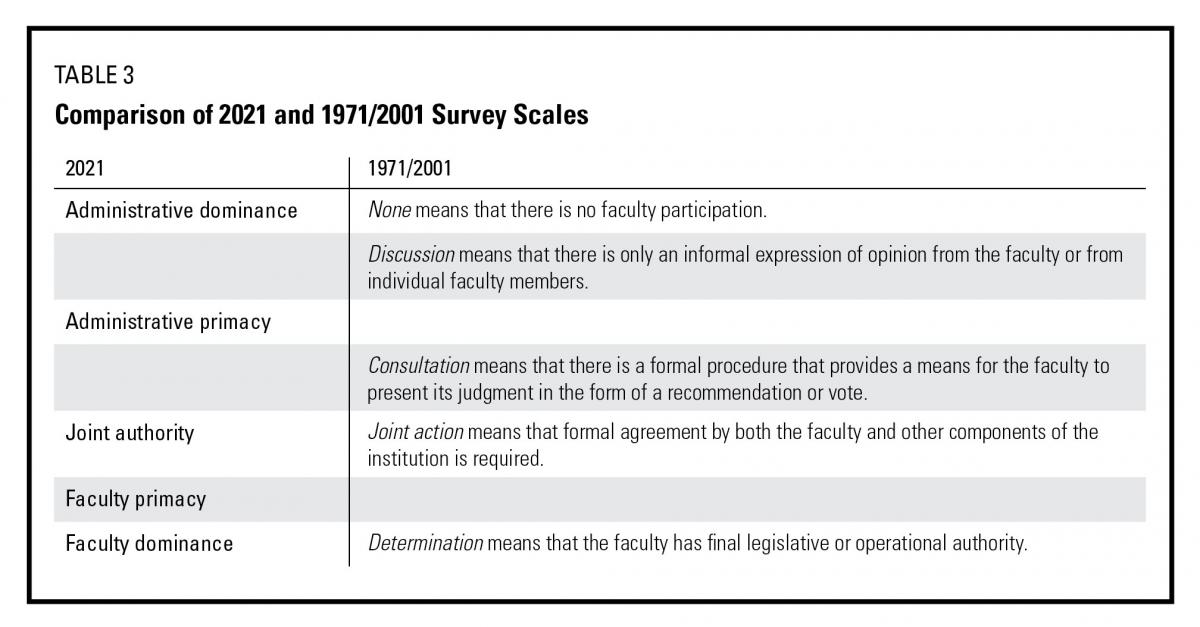 Only twelve areas were included in all three surveys, and in addition to differences in the scales, a second challenge to direct comparability of these twelve areas is that four of them were described in somewhat different terms across the three surveys. Table 4 provides language from the surveys employed to describe approximately similar areas.
Only twelve areas were included in all three surveys, and in addition to differences in the scales, a second challenge to direct comparability of these twelve areas is that four of them were described in somewhat different terms across the three surveys. Table 4 provides language from the surveys employed to describe approximately similar areas.

The 2001 survey included a subset of fifteen of the thirty-one areas used in the 1971 survey with the same wording. The 2001 survey and the current survey both omitted several areas that appeared in the 1971 survey because they no longer seemed relevant or timely. These included questions about student discipline (most notably in response to “riots” and “sit-ins”). The 2021 survey modified other areas from the earlier surveys to provide new response choices where the faculty authority scale did not seem to be the most appropriate mechanism for assessing faculty participation, including for items about the selection of faculty representatives and participation in presidential searches. I will report on results in these areas at a later date.
The comparison of the development of faculty authority from 1971 to 2021 aligns the scale points “joint action” and “joint authority,” allowing comparison of the overall percentage of responses above and below those two scale points. It is important to stress that “joint action” was not the middle category in the 1971 scale, so the number of scale points below that category is higher than the number above. Nevertheless, this way of comparing the survey results is defensible based on the definitional equivalence between the two points across the surveys. The findings are summarized in figures 6, 7, and 8. 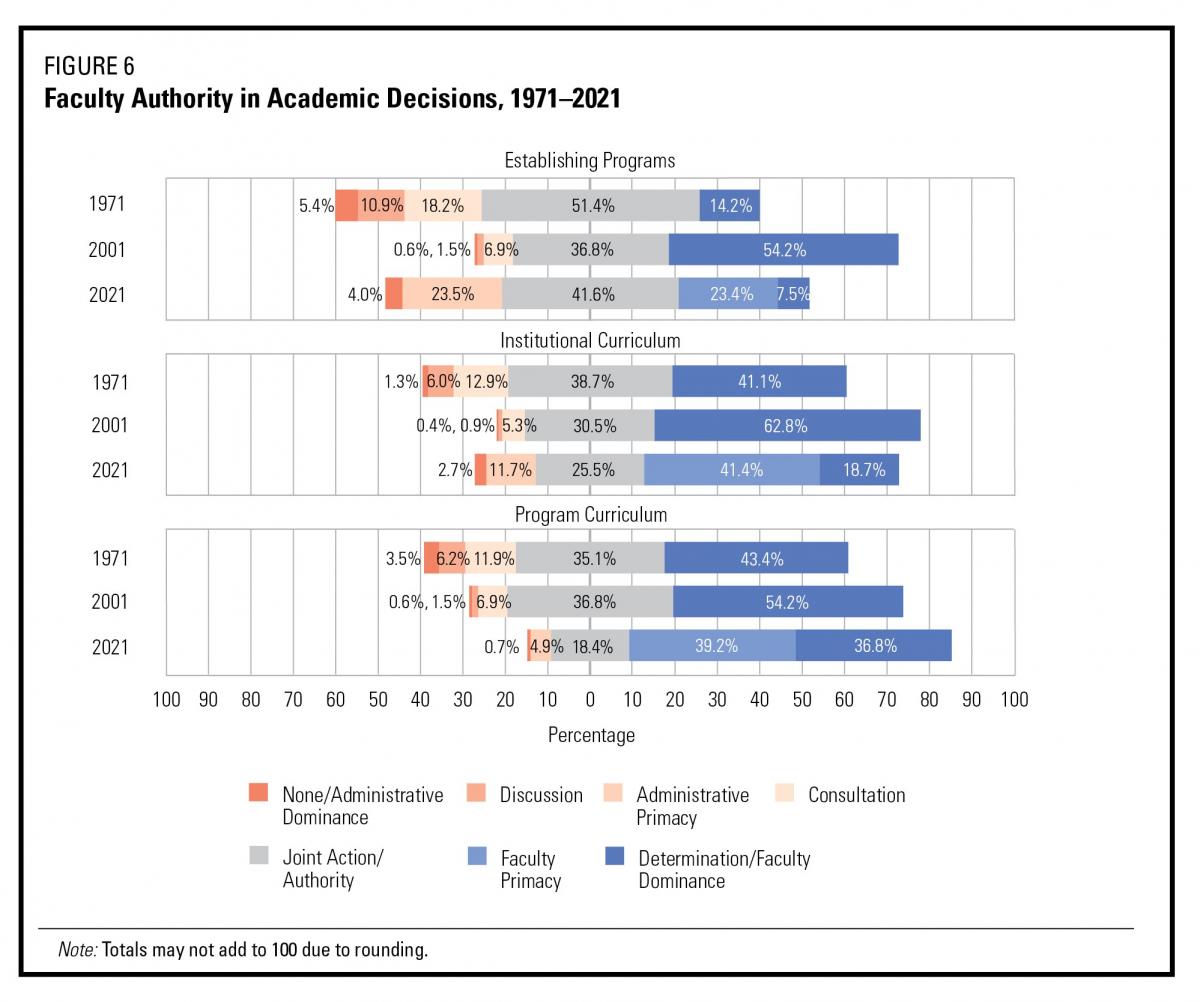
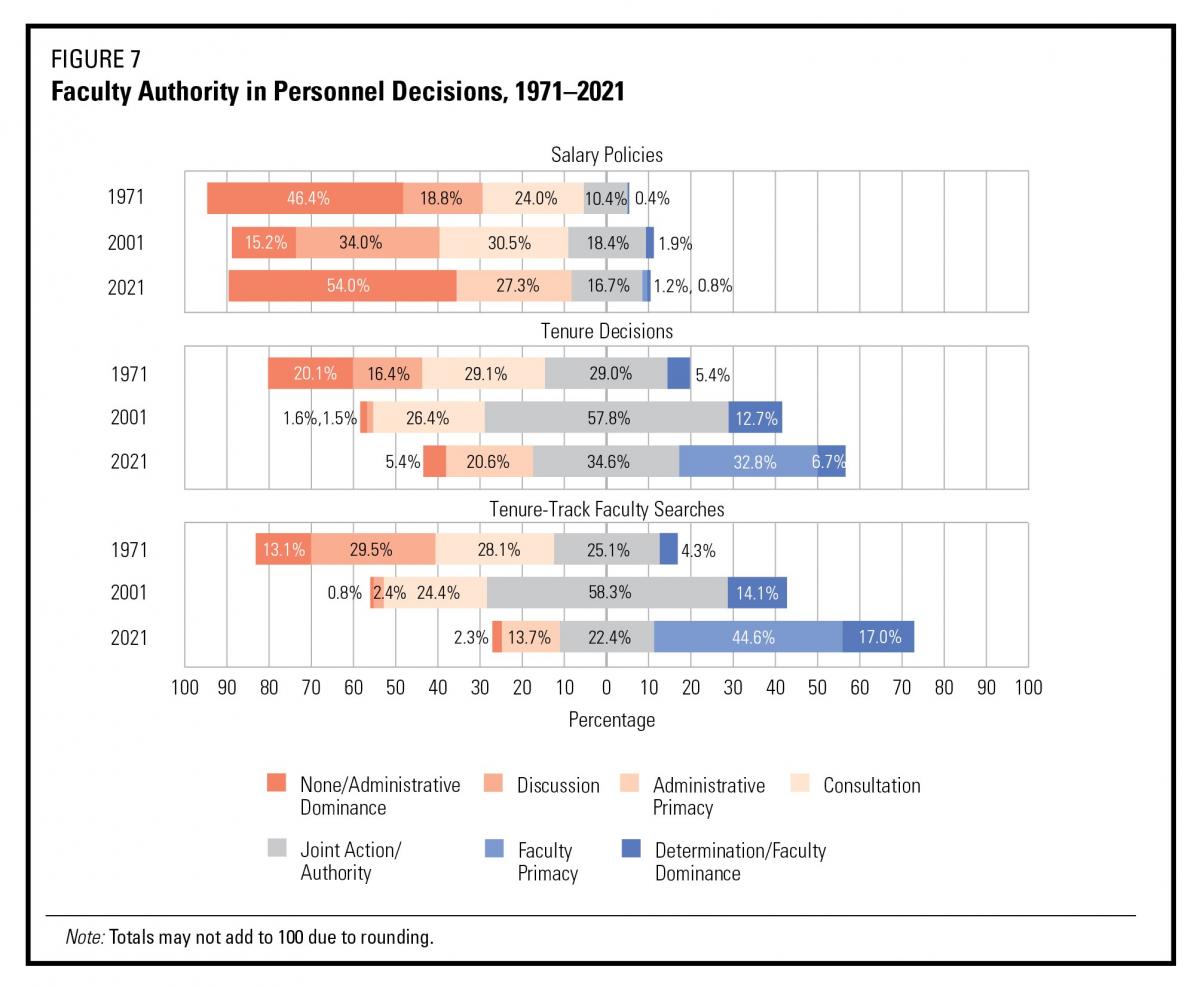
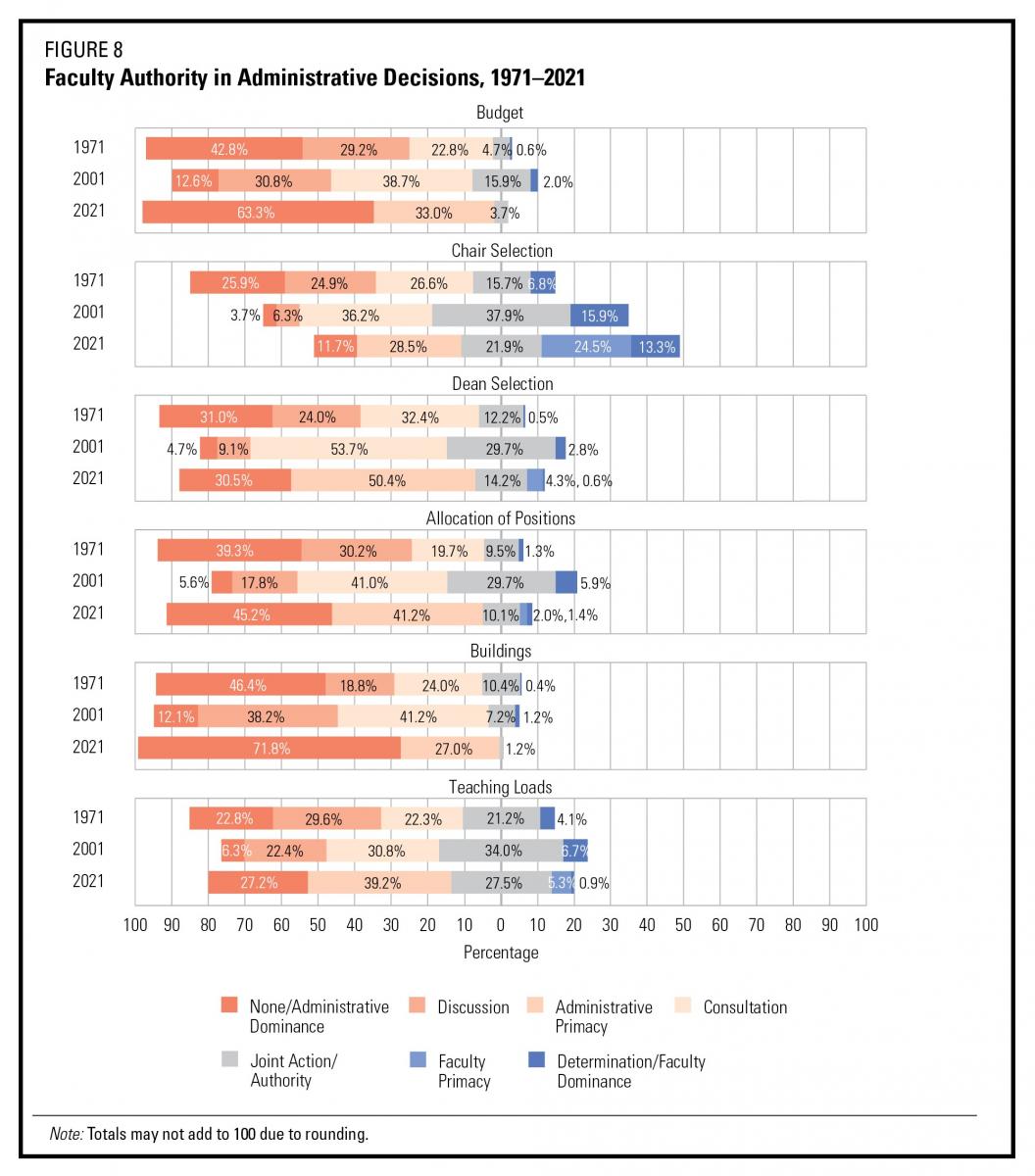
In the academic grouping, the historical comparison shows an increase in faculty authority regarding decisions about departmental or program curricula, a small decrease in faculty authority regarding decisions about institutional curricula, and a larger decrease in faculty authority regarding decisions about the creation of programs. In the areas of the personnel group, the level of faculty authority concerning salary policies increased from 1971 to 2001, most likely because of the increase in faculty collective bargaining during that time, and that level has stayed relatively constant. Both tenure decisions and decisions about searches for tenure-track faculty members saw an increase in faculty authority.
The six administrative items included in the three surveys present a somewhat mixed picture. Decisions about budgets, the appointment of deans, the allocation of positions, and teaching loads show increases in faculty authority from 1971 to 2001 but decreases since then. Decisions about buildings show a steady decline in faculty authority since 1971, while decisions about chair appointments show an increase across the three surveys.
One way to look at the changes across these various areas is that local decision-making—that is, decision-making at the departmental or programmatic levels, including promotion and tenure decisions, programmatic curricular decisions, and the selection of department chairs—has seen a steady increase in faculty authority over the past five decades. By contrast, in broader institutional areas—institutional curricular decisions, the establishment of programs, and the selection of deans—the faculty has generally lost ground over the course of the last two decades.
VII. Conclusion
The purpose of the 2021 AAUP Shared Governance Survey was to provide information about the state of academic governance twenty years after the publication of findings from the last national survey. The overall results of this survey present a mixed picture of the current state of shared governance. At most institutions, faculty authority is consistent with AAUP-recommended governance standards in decision-making about programmatic, departmental, and institutional curricula; teaching assignments; and faculty searches, evaluations, and tenure and promotion standards. However, in several decision-making areas, including budgets, buildings, and allocations of faculty positions, the faculty has little or no meaningful opportunity to participate. Although questions continue to be raised about the relationship between collective bargaining and shared governance, this survey did not find statistically significant differences between the two types of institutions in the vast majority of areas, and most of the significant differences it did find related to terms and conditions of employment, where differences would be expected and had been found in previous surveys.
An additional reason for conducting this shared governance survey was to compare current findings about the state of academic governance with previous findings. From a historical perspective, the overall findings of this survey are also mixed. Particularly striking are several areas in which the faculty had made progress in its decision-making authority between 1971 and 2001 but has since returned to the status of 1971 or worse—most notably in the allocation of faculty positions and in budgetary matters. By contrast, several areas of decision-making that are local in scope, such as programmatic curricular decision-making or the selection of department chairs, have seen an increase in faculty authority.
As noted above, I discuss findings on the effects of the COVID-19 pandemic in “Survey Data on the Impact of the Pandemic on Shared Governance.” Those findings make clear that the pandemic has had a negative effect on the faculty role in governance at some institutions, and the report of the AAUP’s recent governance investigation, COVID-19 and Academic Governance, provides detailed accounts of breakdowns of shared governance at selected individual institutions. A central question for future shared governance surveys will be whether the pandemic had a lasting effect that resulted in a further deterioration in the faculty’s authority, particularly in institutional, as opposed to departmental, decision-making.
Appendix: Methodology
The results of this study are intended to be generalized to a population of 1,422 public and private nonprofit institutions of higher education that the Carnegie system classifies as bachelor’s, master’s, or doctoral institutions. I drew the sample used for the study from that population, excluding all-online institutions, along with institutions that reported having no full-time faculty or answered “not applicable” to the IPEDS question about the existence of a tenure system. I administered the questionnaire to senate chairs and faculty governance leaders in a similar role at a stratified random sample of 585 institutions, choosing one respondent at each institution. In four instances, at institutions where the faculty union rather than a senate or a similar body fulfilled faculty governance functions on campus, I selected the president of the faculty union. The choice of respondents based on their role in an institution (in this case, the governance system) is a common practice in organizational surveys, where such respondents are called “key informants.”
At fifteen institutions where contacts reported that there was no suitable respondent for the survey, I substituted the institutions in the sample with other institutions from the same stratum (see table 5 for a list of strata). At those institutions, full-time administrators chaired all committees, and no person designated as faculty chair or faculty secretary existed. Given the overall design of the survey, there was no practicable way of identifying an alternative respondent, so substitution appeared to be the best solution. These were predominantly small and medium-size bachelor’s and master’s institutions, several of which did not have a tenure system. It can be assumed that the faculty role in governance at those institutions would be generally weaker than at institutions that had a suitable respondent; thus, the substitution may have biased results. In view of the small number of institutions (about 2.5 percent of the sample), it seems unlikely to have had a large effect.
I stratified the population by tenure system, Carnegie classification, and size into six strata and drew disproportionate, random samples from each stratum, oversampling small strata and undersampling large ones. The measure of size was based on the Carnegie classification system as well and consisted of three categories: small (fewer than two thousand students), medium (between two thousand and five thousand students), and large (more than five thousand students). The purpose of these sampling choices was to ensure that we had adequate numbers of institutions with each of those characteristics for further analysis. Table 5 provides information about the size of the strata, the size of the samples, and the response rates.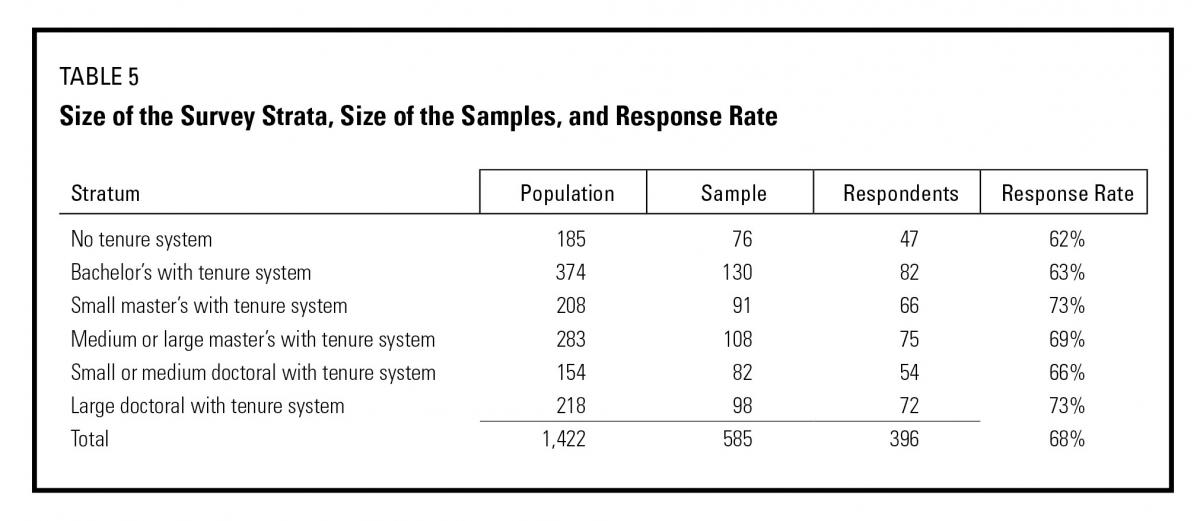 The overall response rate was 68 percent. The response rates in the different strata were relatively uniform. To improve the accuracy of the estimates, I weighted the results of the study with design weights to account for the disproportionate selection across the different strata, nonresponse weights, and poststratification weights based on the prevalence of institutional control in the population (since control was not used to define strata). Estimates of proportion in the population made on the basis of a sample have a margin of sampling error. That margin depends on the sampling design (the “design effect”), the size of the sample, and the estimated proportion itself. With 396 respondents in this stratified sample, it is +/− 4.3 points when the proportion reported is 50 percent, which is when the margin of error is largest for a given sample size. Thus, for example, the estimate that 49.6 percent of institutions reported that the level of faculty authority in provost searches is “administrative primacy” has a 95 percent confidence interval of 45.3 percent to 53.8 percent. The margin of error is larger when proportions are reported for subpopulations (such as by Carnegie classification, collective bargaining status, and so forth).
The overall response rate was 68 percent. The response rates in the different strata were relatively uniform. To improve the accuracy of the estimates, I weighted the results of the study with design weights to account for the disproportionate selection across the different strata, nonresponse weights, and poststratification weights based on the prevalence of institutional control in the population (since control was not used to define strata). Estimates of proportion in the population made on the basis of a sample have a margin of sampling error. That margin depends on the sampling design (the “design effect”), the size of the sample, and the estimated proportion itself. With 396 respondents in this stratified sample, it is +/− 4.3 points when the proportion reported is 50 percent, which is when the margin of error is largest for a given sample size. Thus, for example, the estimate that 49.6 percent of institutions reported that the level of faculty authority in provost searches is “administrative primacy” has a 95 percent confidence interval of 45.3 percent to 53.8 percent. The margin of error is larger when proportions are reported for subpopulations (such as by Carnegie classification, collective bargaining status, and so forth).
HANS-JOERG TIEDE
Director of Research, AAUP
[1] Otway Pardee et al., “Report of the Survey Subcommittee of Committee T,” AAUP Bulletin 57, no. 1 (1971): 68‒124, and Gabriel E. Kaplan, “How Academic Ships Actually Navigate,” in Governing Academia: Who Is in Charge at the Modern University?, ed. Ronald G. Ehrenberg (Ithaca, NY: Cornell University Press, 2005). For a historical discussion of these and earlier governance surveys conducted by the AAUP, see Larry G. Gerber, The Rise and Decline of Faculty Governance: Professionalism and the Modern American University (Baltimore: Johns Hopkins University Press, 2014).
[2] Joseph W. Garbarino and Bill Aussieker, Faculty Bargaining: Change and Conflict (New York: McGraw-Hill, 1971).
[3] American Association for Higher Education, Faculty Participation in Academic Governance: Report of the AAHE Task Force on Faculty Representation and Academic Negotiations (Washington, DC: American Association for Higher Education, 1967).
[4] Although governing boards, of course, participate in shared governance, the scale focused on the relative roles of the faculty and the administration, because it was completed by faculty governance leaders who tend not to interact with the board as an entity that is separate from the administration. That is, in the areas of decision-making explored in this study, the faculty does not generally have separate dealings with the administration and the board but rather with the administration as the representative of the board. If this type of questionnaire were to be administered to university presidents, for instance, it would be highly appropriate to have separate scales about levels of authority of the administration and the faculty, on the one hand, and of the administration and the board, on the other. The present questionnaire included items about faculty representation on the board and faculty-board communication, which later reports will address.
[5] “Survey Data on the Impact of the Pandemic on Shared Governance,” https://www.aaup.org/report/survey-data-impact-pandemic-shared-governance.
[6] The AAUP’s research department released a report on the prevalence of certain policies in these areas last year; see “Policies on Academic Freedom, Dismissal for Cause, Financial Exigency, and Program Discontinuance,” Academe, Summer 2020, 50‒65.
[7] Dan L. Adler, Governance and Collective Bargaining in Four-Year Institutions, 1970‒1977 (Washington, DC: Academic Collective Bargaining Information Service, 1978).

